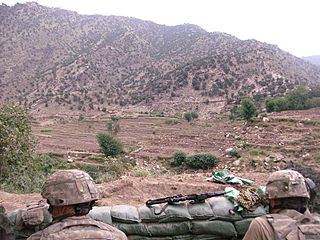
The Taliban insurgency began after the group's fall from power during the 2001 War in Afghanistan. The Taliban forces fought against the Afghan government, led by President Hamid Karzai, and later by President Ashraf Ghani, and against a US-led coalition of forces that has included all members of NATO; the 2021 Taliban offensive resulted in the collapse of the government of Ashraf Ghani. The private sector in Pakistan extends financial aid to the Taliban, contributing to their financial sustenance.

Operation Mountain Fury was a NATO-led operation begun on September 16, 2006 as a follow-up operation to Operation Medusa, to clear Taliban insurgents from the eastern provinces of Afghanistan. Another focus of the operation was to enable reconstruction projects such as schools, health-care facilities, and courthouses to take place in the targeted provinces.

A series of occasional armed skirmishes and firefights have occurred along the Afghanistan–Pakistan border between the Afghan Armed Forces and the Pakistan Armed Forces since 1949. The latest round of hostilities between the two countries began in April 2007. Militants belonging to Tehrik-i-Taliban Pakistan and Jamaat-ul-Ahrar also use Afghanistan's territory to target Pakistani security personnel deployed along the border. The Diplomat says that the presence of terrorists belonging to Tehrik-i-Taliban Pakistan on Afghan soil is the reason for sporadic shelling of Afghanistan's territory by Pakistani security forces.

The following items form a partial timeline of the War in Afghanistan. For events prior to October 7, 2001, see 2001 in Afghanistan.
Events from the year 2007 in Afghanistan.

The Battle of Wanat took place on July 13, 2008, when around 200 Taliban insurgents attacked American troops stationed near Quam, in the Waygal district of Afghanistan's far eastern Nuristan province. The distant position was primarily defended by United States Army soldiers with 2nd Platoon, Chosen Company, 2nd Battalion, 503rd Infantry Regiment (Airborne), 173rd Airborne Brigade Combat Team.

The Pakistani Taliban, formally called the Tehreek-e-Taliban-e-Pakistan, is an umbrella organization of various Islamist armed militant groups operating along the Afghan–Pakistani border. Formed in 2007 by Baitullah Mehsud, its current leader is Noor Wali Mehsud, who has publicly pledged allegiance to the Afghan Taliban. The Pakistani Taliban share a common ideology with the Afghan Taliban and have assisted them in the 2001–2021 war, but the two groups have separate operation and command structures.
United States and NATO International Security Assistance Force (ISAF) operations, alongside Afghan National Army forces, continued against the Taliban through 2008.
The border skirmishes between the United States and Pakistan were the military engagements and confrontations between Pakistan and the United States that took place along the Afghanistan-Pakistan border from late 2008 to late 2012 resulting in the deaths of 55 Pakistani personnel with a unknown number of U.S. casualties. These incidents involved the U.S. Forces-Afghanistan Command and ISAF forces, who had been present in Afghanistan fighting Taliban and al-Qaeda insurgency, and the unified Western military command of the Pakistan Armed Forces against one another in a series of skirmishes that ceased shortly after the 2011 NATO attack in Pakistan. The two sides ultimately made peace and continued collaboration operations against insurgent groups in Pakistan following an official, but brief, apology from then-U.S. Secretary of State Hillary Clinton on 3 July 2012 over the loss of life suffered by the Pakistani military.
Events from the year 2008 in Afghanistan.
Events from the year 2011 in Afghanistan.

The 2011 NATO attack in Pakistan was a border skirmish that occurred when United States-led NATO forces engaged Pakistani security forces at two Pakistani military checkposts along the Afghanistan–Pakistan border on 26 November 2011, with both sides later claiming that the other had fired first. Two NATO Apache helicopters, an AC-130 gunship and two F-15E Strike Eagle fighter jets entered as little as 200 metres (660 ft) to up to 2.5 kilometres (1.6 mi) into the Pakistani border area of Salala at 2 a.m. local time. They came from across the border in Afghanistan and opened or returned fire at two Pakistani border patrol check-posts, killing 28 Pakistani soldiers and wounding 12 others. This attack resulted in deterioration of relations between Pakistan and the United States. The Pakistani public reacted with protests all over the country and the government took measures adversely affecting the American exit strategy from Afghanistan, including the evacuation of Shamsi Airfield and closure of the NATO supply line in Pakistan. Pakistan also rejected a U.S. offer of compensation for the killing of its soldiers in the NATO attack.
The following lists events that happened in 2013 in Afghanistan.
The following lists events that happened during 2015 in Afghanistan.
The following lists events that happened during 2016 in Afghanistan.

On 28 June 2011, a group of nine gunmen and suicide bombers attacked the Inter-Continental Hotel, Kabul. The attack and an ensuing five-hour siege left at least 21 people dead, including all nine attackers. Responsibility was claimed by the Taliban.
Events in the year 2017 in Afghanistan.
This article summarizes the history of the War in Afghanistan (2001–2021).







